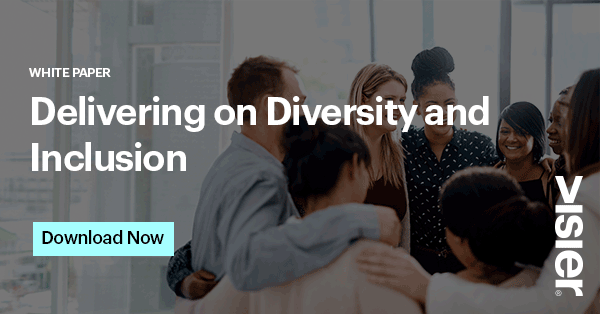How Neurodiverse Employees Move Your Business Forward
Discover how neurodiverse employees with specific cognitive profiles will be best supported within your business and how to hire for these individuals.

This article first appeared in Recruiting Daily and has won 2nd place in their 2019 Recruiting Brief MVP Awards Diversity and Inclusion category!
A good friend from my home country of Scotland always struggled to keep up with his peers in school. But he also succeeded where most people would have failed.
Early on in his career as an engineer, he designed and built a huge dome — essentially a projection screen stretched over curved pieces of metal — for Dynamic Earth, a conference venue and geology visitor attraction in Edinburgh.
The dome needed to represent the earth’s 23.5-degree tilt. Figuring out how to create this effect with different pieces of metal required an exceptionally high level of 3D spatial ability, and my friend rose to the challenge. The end result was a dramatic and memorable centerpiece for exhibits and gala dinners.
No doubt, my friend was helped by a little dose of grit, but he also accomplished this tremendous feat because he saw the world a little differently. His unique perspective is likely the result of a neurological trait he has in common with Jamie Oliver and Richard Branson: dyslexia.
The Unique Talents of People on the Edges
There is a growing consensus that people who are neurodivergent (i.e. are wired differently than the bulk of the population) are a necessary prerequisite for innovation and business success.
People with dyslexia, for example, tend to have strong problem-solving and spatial reasoning capabilities, and individuals on the autistic spectrum tend to excel in areas like rule-based thinking. Many organizations are experiencing benefits from including individuals with these strengths in their workforces.
JPMorgan Chase, for example, hired more than 70 employees with autism between 2015 and 2018. As the executive director and head of Autism at Work at Chase told Fortune, people on the spectrum are highly focused and less distracted by social interactions. “Our autistic employees achieve, on average, 48% to 140% more work than their typical colleagues, depending on the roles,” he said.
Since Microsoft launched its Autism Hiring Program in 2015, at least 50 full-time employees have joined the company through the initiative. They perform a variety of roles, from software engineering and data science to content writing.
There are also systemic efforts to leverage the talents of people with dyslexia. Exceptional Individuals is a recruiting agency that matches employers with dyslexic candidates, and Ernst & Young recently partnered with a charity to deliver a report showing the value of dyslexia in the changing world of work. One marketing firm even posted an “only dyslexics need apply” job ad.
While deliberately excluding people from applying for a position is a controversial tactic that may not gain widespread traction, it represents the beginnings of a shift in the way employers view neurodivergent candidates: not as a burden, but as an asset.
Neurodiversity and The Future Of Work
If your company does not need neurodivergent employees today, it will definitely need them tomorrow. Business models are subject to rapid disruption, and established incumbents are struggling to survive in volatile business environments. An organization can not stay ahead of the curve if all its people are thinking the same way.
At the same time, an increasing number of companies — from all industries — require the kind of technical talent normally found in Silicon Valley (a hub for people on the autistic spectrum).
However, there is a long way to go before the neurodivergent talent pool is fully tapped. People with dyslexia are not more or less intelligent than the general population, and yet, they are more likely to be unemployed than those who are not dyslexic. Around 85% of college grads affected by autism are unemployed.
Take An Evidence-based Approach To Neurodiversity
If you are a business leader who wants to start seeking out individuals from the neurodivergent talent pool, you must actively recruit and retain these types of workers by design. Business as usual tactics will not work. Thankfully, with several industry leaders entering the foray, there are a number of best practices to follow so that you don’t have to do this based on gut feel.
Keep in mind, however, that you are going to be introducing new variables into your unique workforce ecosystem. What worked for another organization may not work for yours, and without proper care, there can be unintended consequences.
A good approach is to supplement industry best practices with the results from an internal pilot program. Once you have an understanding of how workers with specific cognitive profiles are best supported within your business, you can then implement neurodiversity initiatives based on hard evidence. Follow these steps to get started:
Step 1: Understand the Role
The first step is to determine how neurodivergent individuals can be deployed in your organization to meet business objectives. Take a look at the roles that will be in demand six to 12 months out and what kind of strengths will be needed to perform those roles. For example, roles requiring careful data analysis and pattern recognition is one area where people on the spectrum tend to perform well.
You will also need to find a manager who is willing to work with people who have the relevant neurodivergent strengths. Look for flexible, emotionally intelligent managers who are able to lead teams with diverse needs and capabilities.
Step 2: Craft Inclusive Job Ads
There are several ways you can increase the chances of a neurodivergent worker applying for a role. Simply stating in your job ads that you welcome applications from people who have dyslexia, for example, will go a long way in terms of increasing your odds that individuals with this trait will enter the candidate pool.
The number of groups and associations representing people with dyslexia and autism is increasing. Reach out to these associations — they can help connect you with the right candidates.
Step 3: Hire the Best Candidate for the Job
At this stage, a significant revamp of your interview process may be required. Many people on the autistic spectrum do not get past the interview stage because lack of eye contact can leave the interviewer feeling that the candidate is not interested in the job.
After Microsoft moved away from a traditional interview setup towards a more evaluative process that involved group work, its hiring managers selected people on the spectrum who were previously looked over. Ensure your selection process focuses more on skills assessment, work output, and group projects than sitdown interviews.
Step 4: Adjust and Observe
Once a neurodivergent candidate is hired, his manager will need to make reasonable adjustments to the working environment. These adjustments may not be intuitive. Most people understand that dyslexia involves challenges with written material, for example, but may not be aware that many people with dyslexia take more time to process information and need more support with time management.
Also pay attention to how other workers react and what is required to get the team working smoothly. Concerns from neurotypical teammates about what is and is not a reasonable performance expectation will need to be handled carefully.
At the end of the day, you want to ensure team performance stays high and the social dynamic of the group is strong.
Where Exceptional Talent Thrives
It used to be that companies won by running established practices better and faster than the rest. But the rules of the game have changed. No longer is it just about efficiency, it’s about coming up with entirely new ways of doing things, and this requires organizations to include people with exceptional talents. When organizations can move past our outdated views of “normal” and embrace the best of human diversity, they thrive.
There are also potential gains for neurotypical workers in all of this: in the process of including people with extreme cognitive functioning, more managers may come to appreciate that everyone has unique limitations and talents, although they may be more subtle. In this way, our differences can be a source of resilience.



